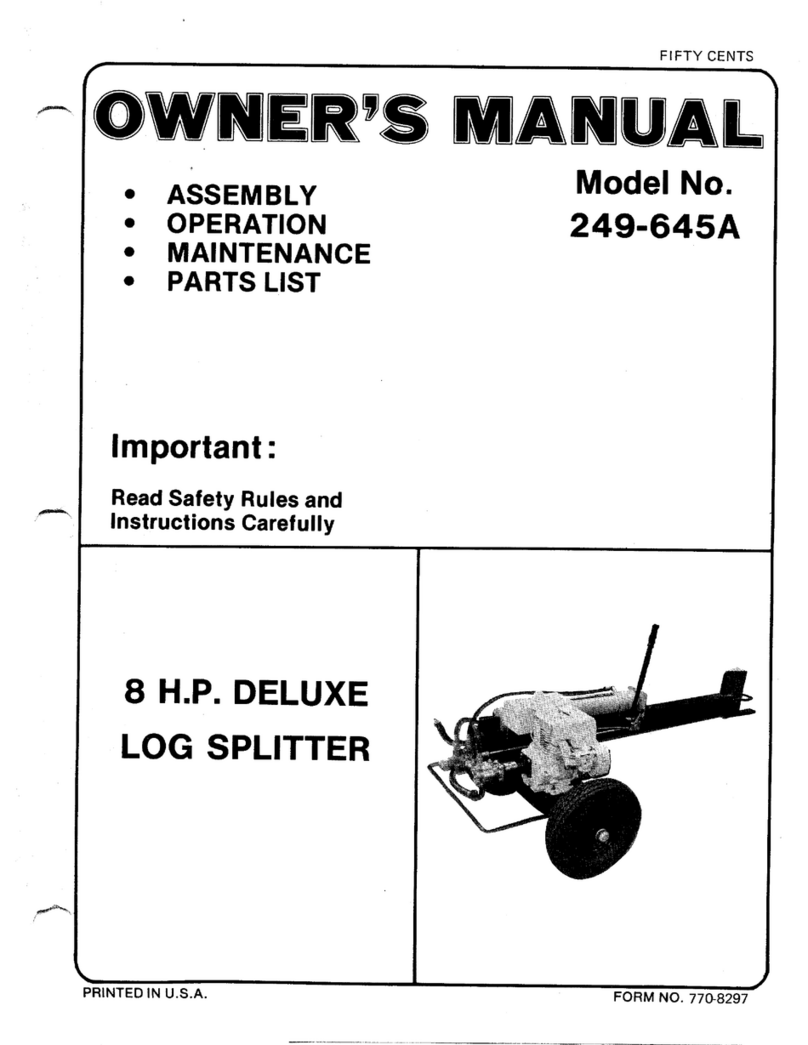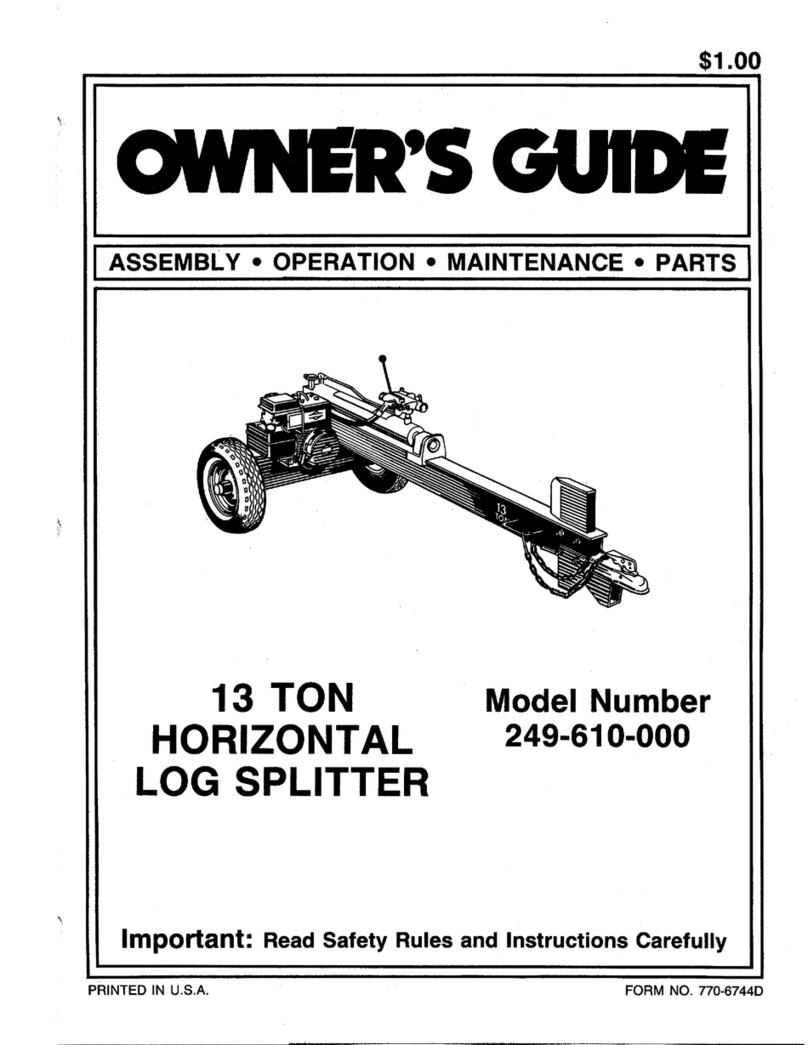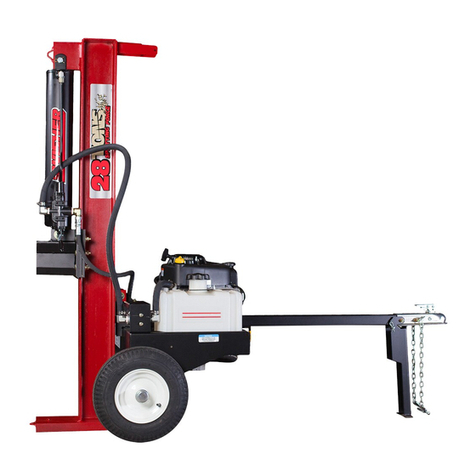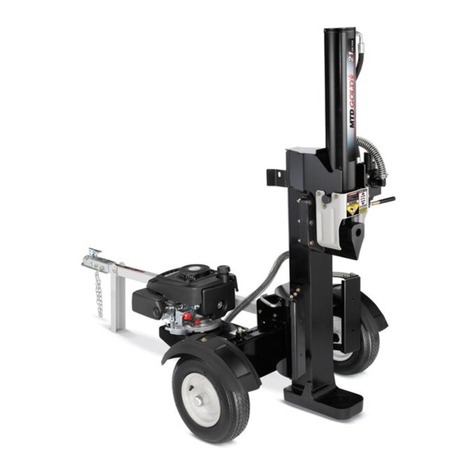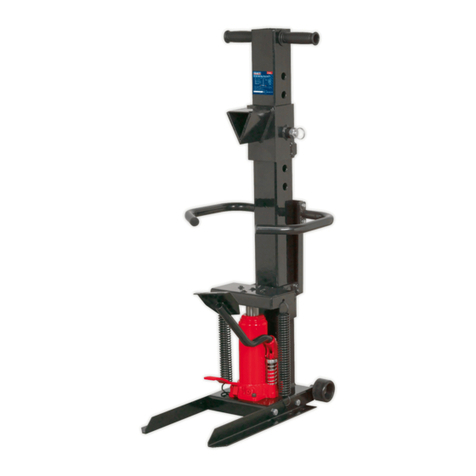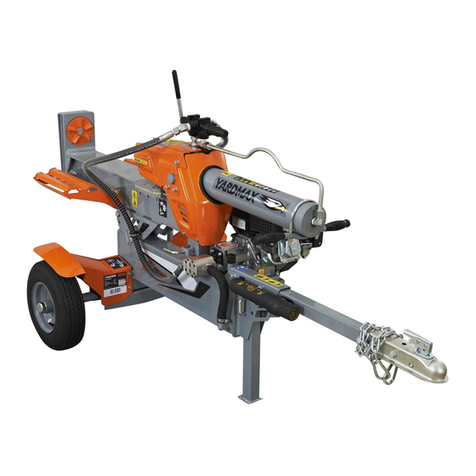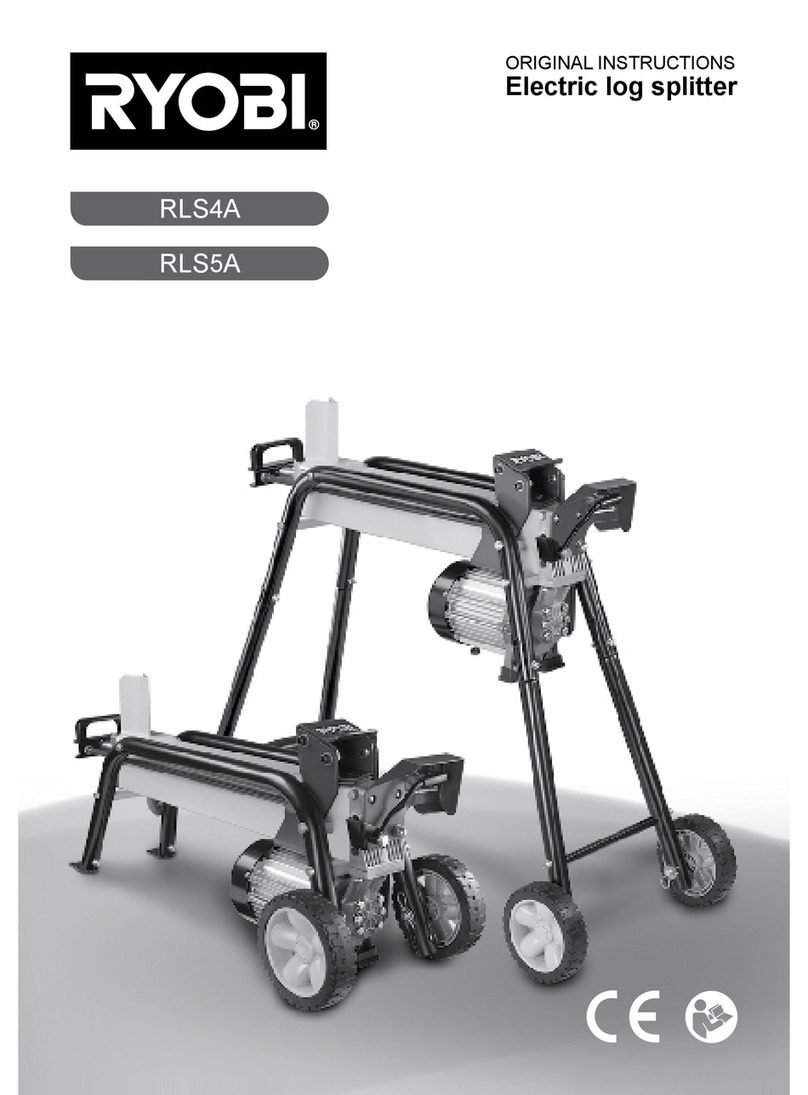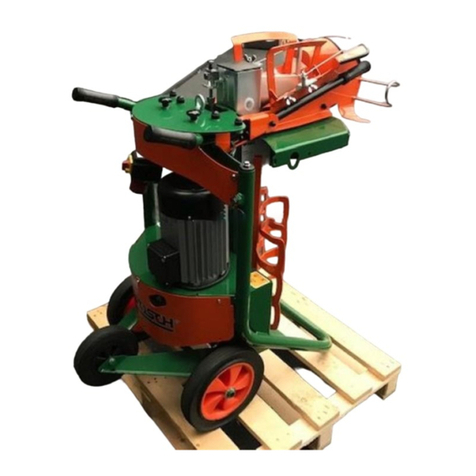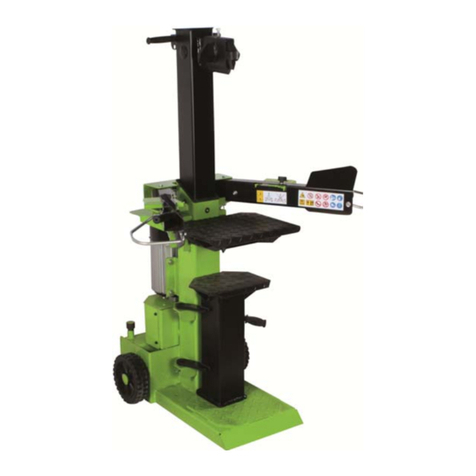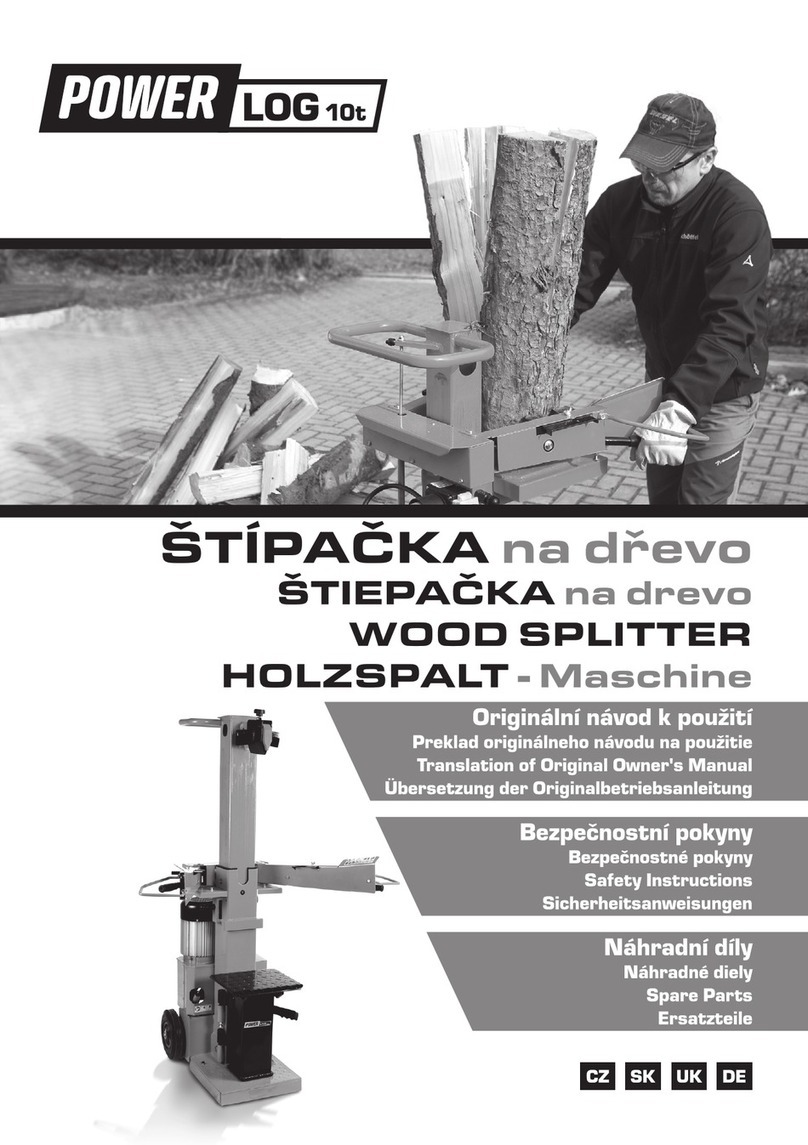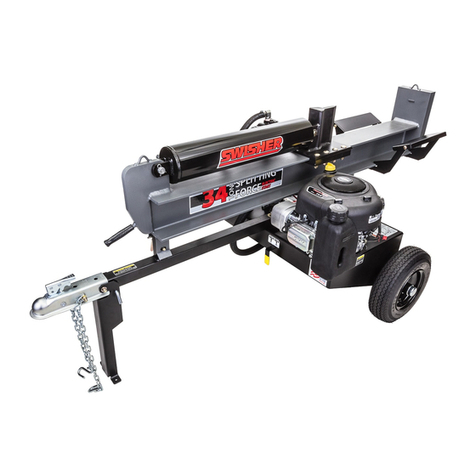Northern Tool + Equipment 334842 User manual

5-TON LOG SPLITTER
OWNER’S MANUAL
WARNING: Read carefully and understand RULES FOR
SAFE OPERATION and instructions before operating.
Failure to follow the safety rules and other basic safety
precautions may result in serious personal injury.
Item #334842

READ ALL INSTRUCTIONS BEFORE OPERATING.
Before attempting to operate your new Log Splitter please read
the instructions thoroughly. You will need these instructions for
the safety warnings, precautions, assembly, operation,
maintenance, parts list and diagrams.
WARNING: The warnings, cautions and instructions
discussed in this manual cannot cover all possible conditions or
situations that could occur. It must be understood by the operator
that common sense and caution are factors, which cannot be
built into this product, but must be supplied by the operator.
SPECIFICATIONS
Force: ……………………… 5 Tons
Operation: ………...…….… Horizontal
HP: …………………………. 1 3/4 HP
Voltage: …………………… 120V
Current: …………………… 15 Amps
Oil Capacity: ……………… 0.6 Gallon
Tire Size: ……………….…. 5 3/4" Diameter
Log Capacity: …………….. 20 1/2" L x 10" Diameter
Cylinder: ………………… 16 3/4" L x 2 1/3" W
Cycle Time: ……………… 9 seconds forward/5 seconds return
SAVE THESE INSTRUCTIONS.
SAFETY RULES
WARNING: The double-insulated system is intended to
protect the user from shock resulting from a break in the tool's
internal wiring. Observe all normal safety precautions related to
avoiding electric shock.
1. Know your machine. Read this manual carefully. Learn
the machine’s applications and limitations, as well as
specific hazards.
2. Ground all machines. This machine is Double Insulated,
meaning that all outside metal parts are insulated from

electrical power. Double Insulated tools are equipped with
a polarized plug. This plug will fit in a polarized outlet only
one way. If the plug does not fit fully in the outlet, reverse
the plug. If it still does not fit, contact a qualified
electrician to install a polarized outlet. Do not attempt to
circumvent this safety feature.
3. Do not expose the tool to moisture. Don’t use this
machinery in damp or wet locations and keep it out of the
rain.
4. Keep the work area clean. Cluttered areas invite injuries.
5. Keep children and pets away. All children should be kept
away from the work area. Never let a child handle a tool
without strict adult supervision.
6. Do not operate this tool if under the influence of alcohol
or drugs or if you are tired. Read warning labels on
prescriptions to determine if your judgment or reflexes are
impaired while taking the medication. If there is any doubt,
do not attempt to operate.
7. Use safety equipment. Eye protection should be worn at
all times when operating this machine. Use ANSI
approved safety glasses. Everyday eyeglasses only have
impact resistance lenses. They are NOT safety glasses.
A dust mask, respirator, non-skid safety shoes, a hard hat,
or hearing protection must be used in appropriate
conditions.
8. Wear the proper apparel. Loose clothing, gloves, neckties,
rings, bracelets, or other jewelry may present a potential
hazard when operating this machine. Please keep all
apparel clear of the machine.
9. Don’t overreach. Keep proper footing and balance at all
times when operating this product.
10. Always disconnect the machine from the power source
before servicing or changing the accessories.
11. Check for damage. Check your tool regularly. If any part
of the tool is damaged it should be carefully inspected to
make sure it can perform its intended function correctly. If
in doubt, the part should be repaired. Refer all service to
a qualified technician. Consult your dealer for advice.
12. Keep away from flammables. Do not attempt to operate
this tool near flammables or combustibles. Failure to
comply may cause serious injury or death.

13. Do not start the log splitter while a log is on the work table.
Always turn the splitter on BEFORE placing a log to be
split on the work table.
14. Always check to make sure that the switch is not
engaged before plugging in power cord.
15. Keep your hands clear of the cutting edges and all
moving parts. Do not place hands between log and
splitting wedge, or between the log and push rod during
operation.
16. Protect others in the work area from debris such as chips
and sparks. Provide barriers and shields as needed.
17. Use the right tool for the job. Do not use a tool or
attachment to do a job for which it was not intended. Do
not alter a tool.
18. Use only authentic accessories. Using noncompliant
accessories may be hazardous. Be sure that all
accessories are properly installed and maintained.
19. Remove all adjusting keys and wrenches. Make a habit of
checking that the adjusting keys and wrenches are
removed from the tool before turning it on.
20. Guard against electric shock. Prevent body contact with
grounded surfaces such as pipes, radiators, ranges, and
refrigerators. Hold your tool by the insulated, non-metal
grasping surfaces. Use a Ground Fault Circuit Interrupter
(GFCI) to reduce shock hazards.
21. Avoid accidental starting. Be sure your tool is turned off
before plugging it in. Do not use a tool if the power switch
does not turn the tool on and off. Do not carry a plugged-
in tool with your finger on the switch.
22. Do not force the tool. Your tool will perform better when
used appropriately. Excessive force only causes operator
fatigue, increased wear and reduced control.
23. Do not abuse the cord. Never carry your tool by its cord
or unplug it by pulling the cord from the outlet. Pull the
plug rather than the cord to reduce the risk of damage.
Keep the cord away from heat, oil, sharp objects, cutting
edges and moving parts.
24. Treat your tools with care. Keep handles dry, clean and
free from oil and grease. Follow the instructions for
lubricating and changing accessories. Periodically inspect

tool cords and extension cords for damage. Refer all
service to a qualified technician.
25. Store idle tools. When not in use, store your tools in a dry,
secure place. Keep out of reach of children.
26. If an extension cord is needed, it must be 121 AWG and
3-wire type.
27. Split only one log at a time.
28. Make sure the log is free of nails or other foreign objects.
29. Never use the log splitter for any other purpose other
than splitting wood.
30. Never attempt to load a log while the push rod is in
motion.
31. When loading a log, place hands on the sides of the log,
not on the ends.
32. Wait for the push rod to stop moving before loading
another log onto the splitter.
33. High pressure and temperatures can be produced in this
log splitter. Never place your hand(s) near a hydraulic
leak, or use your hands to check for leaks. Use a piece of
cardboard or stiff paper to check of leaks in the hydraulic
lines.
WARNING: Do not use the Log Splitter in wet or damp
areas or expose it to rain.
WARNING: Do not use it in areas where fumes from paint,
solvents or flammable liquids pose a potential hazard.
INSPECT YOUR LOG SPLITTER
Check your Log Splitter before turning it on. Keep Guards in
place and in working order. Make a habit out of checking to see
that keys and adjusting wrenches are removed from tool area
before turning it on. Replace damaged, missing or failed parts
before using it.
INSPECT THE LOGS
Make sure there are no nails or foreign objects in the logs to be
split. The ends of the logs must be cut square. Branches must be
cut off so that they are flush with the trunk.
DON’T OVERREACH

Never stand on the Log Splitter. Serious injury could occur if the
tool is tipped or if the wedge is unintentionally contacted. Do not
store anything above or near the Log Splitter where someone
might stand on the tool.
AVOID INJURY FROM UNEXPECTED ACCIDENTS
Always pay full attention to the movement of the Log Push Rod.
CAUTION: Do not attempt to load the log on until the Log
Push Rod has stopped.
CAUTION: Keep your hands out of the way of all moving
parts.
PROTECT YOUR HANDS
Keep you hands away from splits and cracks which open in the
log. They may close suddenly and cause serious bodily injury.
CAUTION: Do not remove jammed logs with you hands.
Don’t leave the Log Splitter until it has come to a complete stop,
is turned off and unplugged.
MAINTAIN YOUR LOG SPLITTER WITH CARE
Keep the Log Splitter clean for safe and efficient performance.
APPLICATION CONDITIONS
This Log Splitter is designed for home use. It is built to operate
best at temperatures between 41ºF and 104ºF. The surrounding
humidity should less than 50% at 104ºF. It should be stored or
transported at temperatures between -13ºF and 131ºF.
NOTE:A small log can be difficult to split when it has knobs
or a particularly tough fiber. On the other hand, it may not be
difficult to split logs with regular fibers even if its diameter
exceeds the maximum diameter specifications.

CONTENTS OF THE SHIPPING CONTAINER
A. Log Splitter ....................................................................1 Set
B. Support Leg ………………….........................................1 pc.
C. Owner’s Manual …………………………………………..1 pc.
D. Loose Part Bag Containing M8 Bolts & Nuts …………5 Sets
SET UP AND PREPARATION
Familiarize yourself with the controls and features of this Log
Splitter in the illustrations.
1. Oil Tank
2. Log Pusher
3. Work Table
4. Wedge
5. Lift Handle
6. Support Leg
7. Work Table Extension
w/Retaining Plates
8. Switch
9. Motor
10. Pushbutton Box
11. Moving Wheels
12. Lift Handle
13. Hydraulic Control Lever
14. Control Lever Guard
15. Bleed Screw
16. Oil Drain Bolt w/Dipstick
17. Max Pressure Limiting
Screw

•Before operating the Log Splitter, the Bleed Screw should be
loosened until air goes in and out of the Oil Tank smoothly.
•Airflow through the Bleed Screw Hole should be detectable
during operations.
•Before moving the Log Splitter, make sure the Bleed Screw is
tightened to avoid Oil leaks.
WARNING: Failure to loosen the Bleed Screw will keep the
air in the Hydraulic System compressed after being
decompressed. Continuous compression and decompression will
blow out seals on the Hydraulic System and cause permanent
damage to the Log Splitter.
WARNING: DO NOT ADJUST THE MAX PRESSURE
LIMITING SCREW! The Max Pressure Limiting Screw is sealed
with glue to ensure that the Log Splitter works under no more
than 5 tons of pressure. The setting was done by qualified
mechanics with professional instruments. Unauthorized resetting
will cause the Hydraulic Pump to fail to output enough splitting
pressure and could RESULT IN SERIOUS INJURY AS WELL AS
DAMAGE TO THE MACHINE.
WIRING DIAGRAM PLUMBING DIAGRAM
qw
qw

OPERATION
1. This Log Splitter is equipped with a ZHB Control System
that requires it to be operated with both hands (the left
hand controls the Hydraulic Control Lever while right
hand controls the Pushbutton Switch). The Log Splitter
will freeze when either hand is absent. Only after both
hands release the controls, will the Log Pusher return to
the starting position.

WARNING: Never force the Log Splitter for more than 5
seconds.
2. After a 5-second interval, the Oil under pressure will
overheat and the machine could be damaged. For an
extremely hard log, rotate the log by 90º to see whether it
can be split in a different direction. If you are not able to
split the log, its hardness exceeds the capacity of the
machine and thus that log should be discarded to protect
the Log Splitter from damage.
3. Always set the log firmly on the Retaining Plates and
Work Table. Make sure the ends of the log are square, so
the log does not twist, rock or slip while being split. Do
not force the blade by splitting the log using only the
upper part of the blade. This could break the blade or
damage the machine.
WARNING: Break the log in the direction of its growing
grain. Do not place the log across the Log Splitter. This is
dangerous and may seriously damage the machine.
WARNING: Do not attempt to split two logs at the same
time. One of them may fly up and hit you.

FREEING A JAMMED LOG
·Release both controls.
·After the Log Pusher moves back
and comes to a complete stop at
the starting position, insert a
wedge wood under the jammed
log.
·Start the Log Splitter and push the
wedge wood completely under the
jammed log.
·Repeat the above procedure with
a sharper sloped wedge wood until
the log is completely freed.
·Do not try to knock the jammed log off. This could
damage the machine or launch the log.
REPLACING HYDRAULIC OIL
Replace the Hydraulic Oil in the Log Splitter
after every 150 hours of use. Take the following
steps.
·Make sure that all the moving parts have
stopped and the Log Splitter is
unplugged.
·Unscrew the Oil Drain Bolt and remove it.
·Turn the Log Splitter over on to the
Support Leg to drain the Hydraulic Oil.
·Turn the Log Splitter over on to the
Motor side and refill with fresh Hydraulic
Oil according to the capacity of the
particular model.
·Clean the surface of Dipstick on the Oil
Drain Bolt and put it back into the Oil
Tank while keeping the Log Splitter
vertical.
·Make sure the level of the Oil is between
the two grooves on the Dipstick.
·Clean the Oil Drain Bolt before

rethreading. Make sure it is tightened to avoid leakage
before returning the Log Splitter to a horizontal position.
NOTE: Check the Oil level periodically to ensure it is between
the two grooves on the Dipstick. Refill when low.
The following Hydraulic Oils are recommend for this
Transmission:
SHELL Tellus 22
MOBIL DTE 11
ARAL Vitam GF 22
BP Energol HLP-HM 22
SHARPENING WEDGE
After using the Log Splitter for some time, sharpen the wedge of
the Log Splitter using a fine-toothed file and smooth any burrs or
crushed areas along the cutting edge.

PARTS DIAGRAM

PARTS LIST


WARRANTY
One-year limited warranty
Distributed by
Northern Tool + Equipment Co., Inc.
Burnsville, Minnesota 55306
Made in China
Table of contents
Other Northern Tool + Equipment Log Splitter manuals


